#handweaving
Explore tagged Tumblr posts
Text
It's important to summon the creature out of the warp before you start to weave
16K notes
·
View notes
Text




Obviously the key reason to get into weaving is the near limitless pride flag potential.
This is 8 metres of trans warp threaded for 5 different twills. Winding the warp went SO MUCH BETTER than my first project a couple weeks ago and I am especially proud of how smoothly my warp chains unravelled.
With the trans yarns I also ordered sample cards for a couple different yarn companies so that I can compose some rainbow flag variants.
Hype hype hypeeeee
13K notes
·
View notes
Text


a couple more pieces from my last warp of 2024 :-)
handwoven cotton, dec. 2024
3K notes
·
View notes
Text
My first hand dyed warp!! I'm absolutely loving this stitch pattern with how it's making the warp POP
Have some weaving asmr!!
#i was So Worried after dyeing that it wouldnt work#but alas i got it on the loom with little issue thank all#weaving#fibercraft#handcraft#handwoven#fiber art#handweaving
877 notes
·
View notes
Text
Fellowship Cloak Weaving Draft
Hi all! I've been kind of quiet on this blog, but I have something really exciting to share today: after six years, I FINALLY figured out the weaving draft for the Fellowship cloaks from Lord of the Rings.
This is a problem I've been trying to figure out since shortly after I made my Legolas cosplay in 2018. The cloaks that the nine members of the Fellowship receive in Lothlórien look like a nondescript gray fabric from far away, but zoom in and you'll see a very complex pattern of horizontal and vertical bars of dark gray and white.
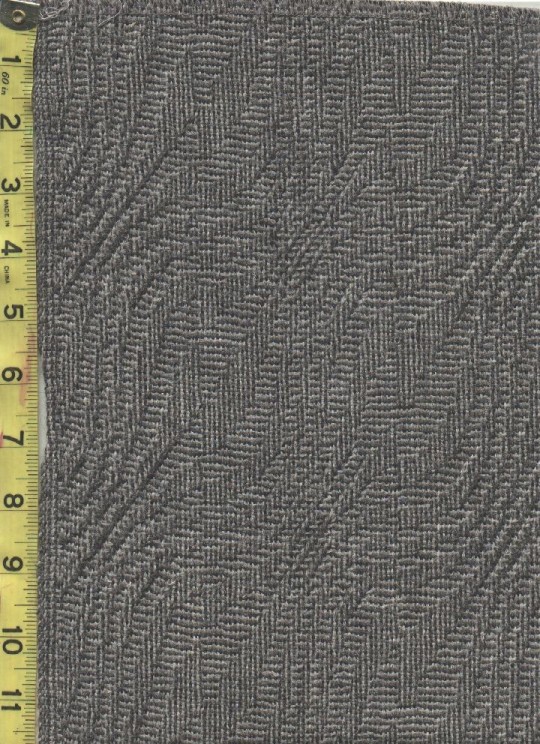
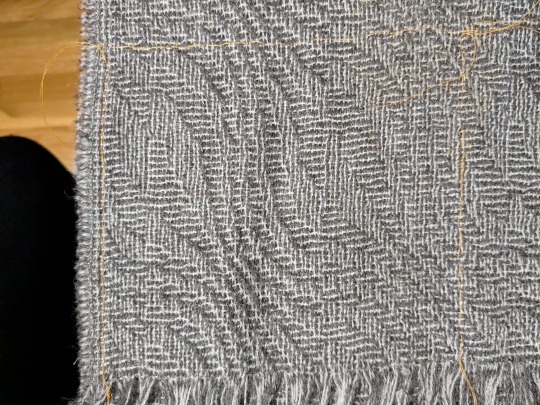
(First image from Alleycatscratch, second is a photo of the scarf of the same fabric I bought from Stansborough where I was attempting to trace the pattern repeat with orange thread)
This is going to be a long post, so I'm just going to lead with the completed draft:

Imagine me Will Smith wife posing at this for the last 24 hours.
It's got the correct size of pattern repeat! It's got the five individual ripples! It's got that dumb little pattern break in the middle that breaks up the center of the leaf motif! I am OVER THE MOON about figuring this out, especially starting out with very little knowledge about weaving drafts in general. More ramblings about this type of draft and my thought process below:
This particular pattern is known as "shadow weave," a subset of color-and-weave where the pattern is created from the interplay of different warp and weft colors plus the weaving draft itself. To get an idea of how that works, let's start by looking at plain weave in one color:

The solid purple bar at the top indicates the color of the warp threads, and the solid purple bar at the right indicates the color of the weft threads. So far we've got our basic under-over-under-over pattern in a single, solid color (purple). But what if we add an additional color (green) to the warp, and alternate those colors? Then we'd get a speckled fabric like this:

The visual effect looks pretty much identical regardless of if you start with green or purple. However, if you also alternate purple and green in the weft, it produces a very different effect depending on if you start with purple or green (note the differences in the bar on the right):


So cool, now we can make either vertical or horizontal stripes! If you double up on the colored threads in some areas, you can even flip between the two and start dividing the fabric into "blocks," like so:


Note that with all these changes, the only thing we've been doing is changing the order of the colors in the warp and weft. The actual weave structure itself is still just regular ol' plain weave. The pattern that we've created in the pictures above is called "log cabin," which you can read about here. But similar effects can be created by skipping shafts/picks in the weaving draft as well. So how do we get from log cabin into the more complicated and general category of shadow weave?
It's weird to describe how to convert a given pattern into shadow weave. There are multiple very good books with chapters on shadow weave as well as books entirely dedicated to it. Despite my best efforts, all these explanations still got so technical so fast it feels like, to me at least, asking a 6 year old to recite an entire Shakespeare play verbatim immediately after confirming that they can, in fact, sing the alphabet song. So I'm going to give my best shot at explaining it, and if it doesn't make sense, just blame it on me and check out some of the linked books above if you're really curious.
Think of shadow weave as a beauty filter for a black and white drawing. If you create a pattern out of black and white blocks/pixels/whatever, the shadow weave "filter" can be applied to it to create a similar pattern that preserves the shapes in the original, but makes them out of vertical/horizontal lines instead of solid color blocks. So in some of these books you'll find mention of converting a twill or an overshot pattern into shadow weave - that's what this is referencing. The original pattern (usually designated with light yarn) gets a secondary shadow pattern (in dark yarn) inserted into in between every other thread (also called an "end" when referencing warp yarns).
I got stuck at this point for literal years. I could find examples of weaving drafts using shadow weave, but couldn't figure out how to generate ones of my own. I imported some of the drafts I found in books into weaving software and poked around to see if I could push the patterns in the direction I wanted by changing individual elements. My experiments in changing individual warp ends and weft picks always ended up looking like stretched or compressed versions of the original pattern (when I was being careful), or incomprehensible garbage (when I was being daring). I even bought a sample of the fabric from Stansborough in the form of a scarf, thinking I could brute force it by using a magnifying glass to figure out the interlacements. I was able to figure out how large the pattern repeat was (approximately 160 x 80 ends), but otherwise I got nothing but eye strain. I ended up tabling the project and coming back to it every couple years, banging my head against it until I gave up.
Until one day last week when I was flipping through the Strickler book and saw this page:

And I was like

HOLD UP
IT'S HER


...or at least a close cousin of her. BUT IT WAS A START.
So the first step was to identify what about this pattern needed to change in order to make this look like the Fellowship cloak. Overall, the main differences were:
Pattern repeat on Strickler 304 was too small - it was 42 x 42 ends and I needed it to be somewhere in the ballpark of 80 x 80 before altering the repeat.
The Fellowship pattern has a weird vertical dividing line that runs down the middle of the leaf motif, effectively doubling the width of the repeat by creating two similar looking but different leaves. This was the change I was least concerned about, as flipping between vertical and horizontal lines is pretty a straightforward process as shown above with the log cabin draft.
Strickler 304 also has a different number of waves (peaks and valleys, or whatever you want to call them) compared to the Fellowship pattern. There are 3 waves in Strickler and 5 in Fellowship. Figuring out how to add these extra waves was the biggest obstacle for me to address.
And finally, a couple of things I didn't need to care about for the weaving draft: 1) the Fellowship pattern is elongated in the warp direction, but this has more to do with a little extra spacing between weft picks as compared to the warp threads. When weaving this you'd just need to make sure you don't beat it very hard and you'll get that tall rectangle shape instead of a square repeat. 2) Both patterns have mirrored symmetry around a diagonal line drawn through the center, meaning that for treadling I could "tromp as writ" or basically just mirror the threading diagram to get the treadling instructions. For reasons I can't figure out, the Strickler pattern isn't exactly tromp as writ but looks close enough to it that the effect is still there. But I don't really care enough to figure out why - the important thing is that it gives us a threading diagram to start with!
So to start with, here's what Strickler 304 looks like in my weaving software:

(By the way, this is Fiberworks PCW Bronze. The trial version is free, and the only difference between that and the paid version is that the save/print options are disabled. I'm not sure they know about screenshots, bless their hearts.)
This is a design for 8 shafts and 8 treadles, thus the 8x8 square in the upper right corner. And you can see in the threading diagram (upper horizontal bar) and treadling diagram (right bar) that the curvature of the waves takes a similar shape to the curves of the final pattern. We just have to figure out why. And since I had already tried changing individual warp ends and treadling patterns without much success, I needed to approach in a different way.
What ended up helping me see the forest for the trees was de-shadowifying the pattern. It's relatively easy to get the black-and-white version of the pattern from the threading draft - you just need to delete the shadow, which means removing every other warp end. This is what deleting all the dark ends from the warp and light ends from the weft looks like:

We can also see with a little more detail how the threading diagram is similar to the curve in the pattern. The pattern is 21 pixels tall, but it's been chopped up to repeat over 8 shafts, like so:

OKAY COOL COOL COOL. EVERYTHING'S COMIN' UP MILHOUSE IVORIVET. From this green squiggly line we know two things:
The final number of warp ends in the shadow weave pattern is double whatever the height of the squiggle is. In the case of the Strickler pattern, we're going from 21 to 42. Since we know that we need our final height for the Fellowship pattern needs to be 80, the squiggle for that pattern needs to be around 40 pixels tall.
We needed to stitch three repeats of the Strickler threading diagram together in order to see the full squiggle. How many waves does the Strickler pattern have? Three. How many waves does the Fellowship pattern need? Five. How many shafts do we have to work on? Eight. What is 5 x 8? 40!!!
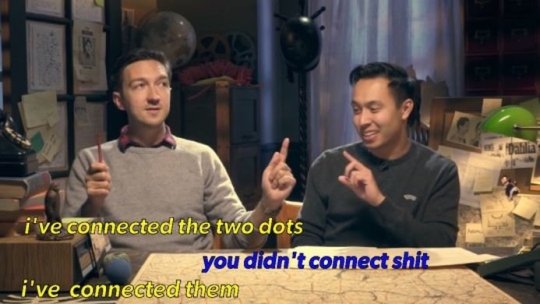
So how about we make a NEW squiggle, only 40 pixels high instead of 21? (We're gonna drop the pixels in blue, since threading diagrams won't work if you put a single end through two shafts.)


Next, we're going to chop up that squiggle and use it to create a new threading diagram in Fiberworks. I'm also using "tromp as writ" here to create the treadling pattern.

LOOK AT THAT. IT'S GOT MORE WAVES!! FIVE OF THEM!
And then we add back in the shadow by creating a space for a new end between each existing end:


And then add in the shadow. I'm using 4 as my number for the shadow offset since we're using 8 shafts. So shaft 1 shadows to shaft 5, shaft 2 shadows to shaft 6, etc.

And we're going to apply tromp as writ again to get:

AYYYYYY WE'RE GETTING CLOSE! I'm fairly certain that the reason why the Strickler treadling wasn't exactly tromp as writ had something to do with centering the pattern repeat a little more than this, but I don't really care about that so I'm going to leave this treadling the way that it is.
From here out, we need at add that weird vertical dividing line that chops up the center of the leaves. So we double the pattern repeat along the horizontal axis, and offset a 40 pixel section in the middle of the threading diagram by 1 pixel. I've also colored in the differences between the dark and light ends to help differentiate the original and shadowed curves a little bit more. (I also tried offsetting the colors of the warp ends by 1 as well like what we did in the log cabin example, but I ended up liking the way that this looked more.)

THERE SHE IS!!! MY PRECIOUS!!

From here on out, there is still a ton of work I need to do if I actually want to weave this cloak from scratch. I did buy roving in quantities that could be used to spin both the dark and light yarn (dark gray Gotland for the dark yarn, and dove gray merino + white alpaca for the light yarn), but there's still the matter of, like, handspinning a cloak's quantity of extremely fine yarn. I did start spinning the Gotland several years ago as fine as I could possibly manage, and got through maybe 20 ounces of it. However, I'm a much better spinner now and I'm not sure if the my skeins from several years ago would be suitable for weaving, or if it would be worth replicating what I did back then vs. just starting over with a new standard. There's also the possibility of just... buying weaving yarn if I want to skip that step, which would definitely save me a significant amount of time.
Anyway, thanks for reading this far and I hope it helped break down why this was so exciting for me!
#lord of the rings#lotr#weaving#lotr cosplay#shadow weave#handweaving#hand weaving#cosplay#fiber arts
904 notes
·
View notes
Text
yk when you see someone share a finished handmade item that they clearly spent a lot of time and money on and it's just. The absolute tackiest thing you have seen in your life. And then you ask yourself why someone would waste all those resources on such an eyesore.
(no, of course you can't relate to that because you're a much nicer person than me)
In any case.
BEHOLD!
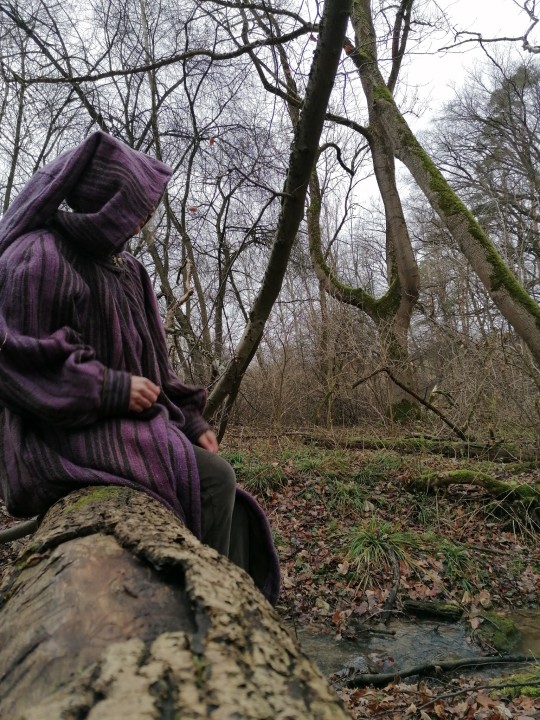
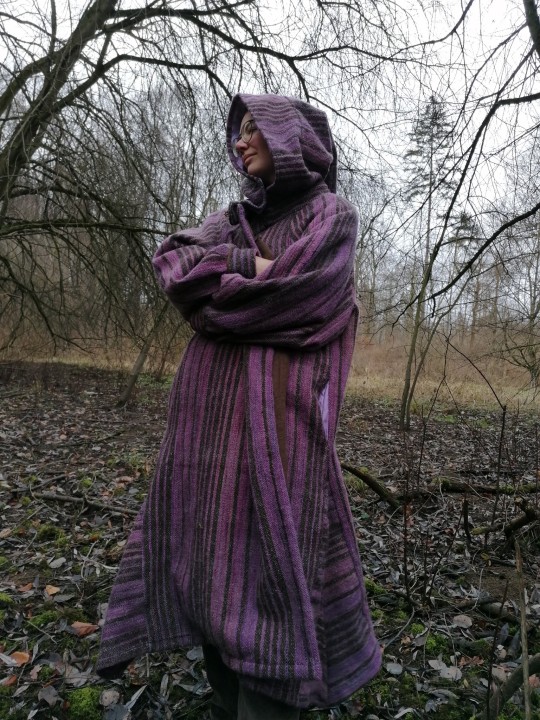
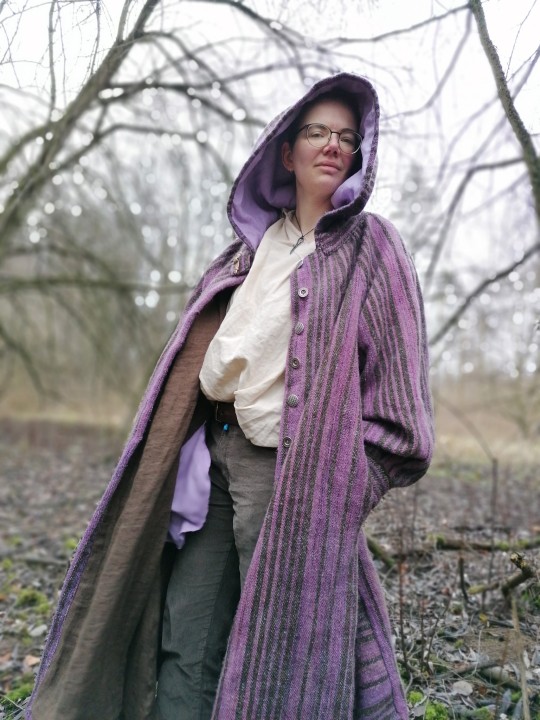
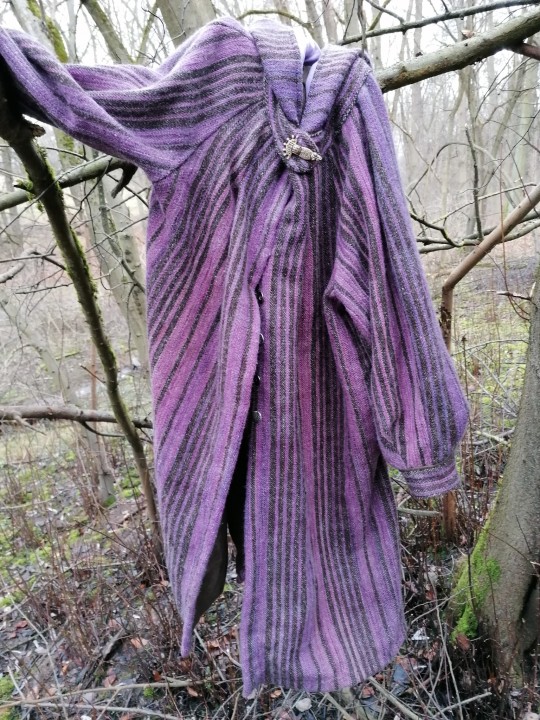
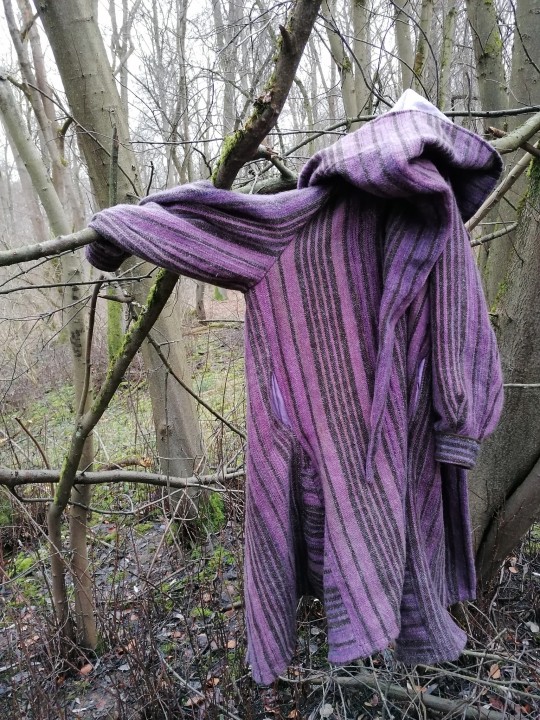
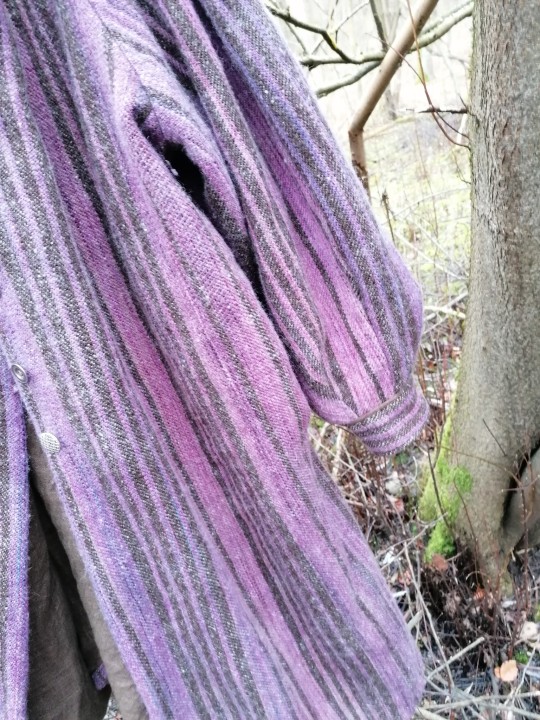
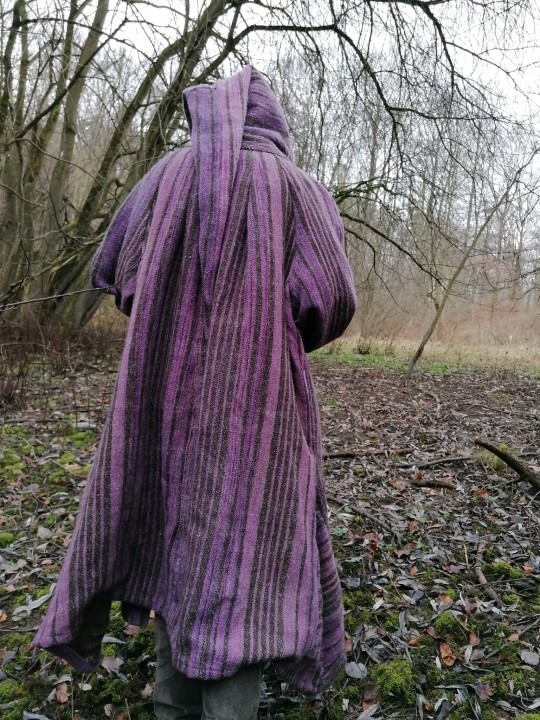
A wool coat!
The top fabric is handwoven and handspun, the whole thing is sewn by hand, too.
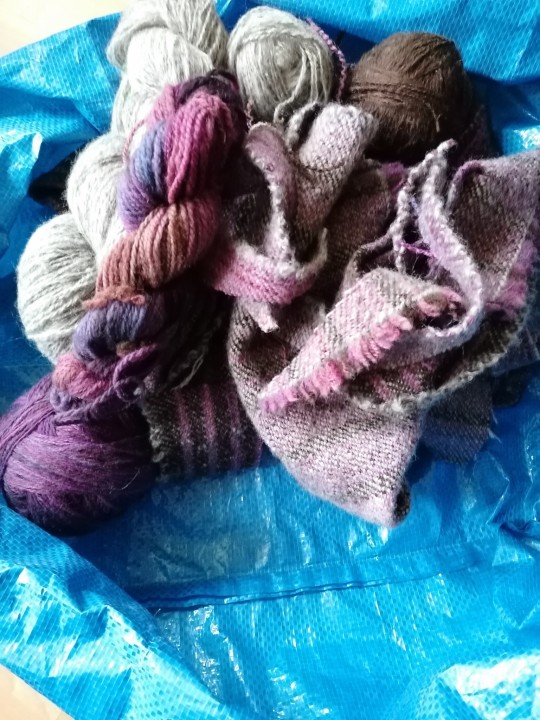
Leftovers. Barely anything, all things considered, which is very satisfying.
This thing took me well over 3 years to make, on and off. And now I'm done.
Thank you for your attention.
#carry on XD#i hope y'all realize that when I say tacky it's with nothing but love in my heart#yes it's ugly. that's the whole point.#everyone should have an item in their wardrobe that will get Looks and raised eyebrows#it's good for you#anyway can't believe I'm done! this is a huge boost to my crafting hubris I CAN DO ANYTHING#wizard bathrobe adventures#handweaving#handspinning#hand sewing#look what i made#crafts#overall I'm happy with it even though there's. things that aren't ideal#the pockets are set a bit too low#and i should have made it a tiny bit longer not much but maybe like 5cm#anyway#overall it's a nice coat i think#Now That's What I Call Slow Fashion
4K notes
·
View notes
Text
smolweaving resources
a masterpost of resources to complement that post going around the other day with a glossary of several different kinds of small weaving. design your own potholder loom squares: https://friendlyloom.com/pages/potholder-design-wizard
make a pin loom: https://windsweptmind.com/2016/07/04/adventures-in-pin-loom-making-and-so-can-you/
warp a pin loom the regular way: https://adventuresinpinloomweaving.com/2018/09/21/choose-your-warping-method/
the diagonal way: https://howdidyoumakethis.com/square-pin-loom-speed-weaving/
fingerweaving
how-to: https://www.metismuseum.ca/fingerweaving/
another how-to: https://nativetech.org/finger/beltinstr.html
additional resources: https://jumaka.com/2019/03/finger-weaving/
tablet weaving
how-to: https://www.shelaghlewins.com/tablet_weaving/TW01/TW01.htm
another how-to: https://jumaka.com/2019/02/card-weaving/
personal favorite site for designing tablet weaving drafts: https://twistedthreads.org/
backstrap rigid heddle weaving
how-to: https://spinoffmagazine.com/backstrap-rigid-heddle-basics-get-weaving-handspun-bands/
3D printed rigid heddle backstrap loom parts:
https://www.thingiverse.com/thing:6141824
3D printed rigid heddles for band weaving:
https://www.thingiverse.com/thing:3999858
inkle loom weaving
how to build a loom from pvc and get started: https://littlelooms.com/a-free-guide-to-inkle-weaving/
inkle loom/rigid heddle backstrap pattern design: https://carolingianrealm.blog/PatternGenerator.php
634 notes
·
View notes
Text
So, exactly one year ago I did this:

It's a fully hand woven pride flag, and this time I went further than ever with all the work. I studied how to weave, I built the weaving loom, and only then wove the flag, which took about two full weeks. It's far from perfect, but I am so proud (pun fully intended) of how it turned out.
It's made with and of love (the rest is 100% cotton 😌); not meant for me, but ended up with me in the end
It will always be a dear memory, with all that it entails

And now, one year from there, I am so so happy ❤️
Wips:
Here for the wips of the weaving loom
Here for the part 1 of the wips of the pride flag
Here for the part 2 of the wips of the pride flag
1K notes
·
View notes
Text



My fabric swatch using 16/2 cotton before and after wet finishing. The process was longer but not as bad as I originally thought, thankfully! Not to pick a pattern to use ☺️
95 notes
·
View notes
Text



Improvised a small loom to test out my handspun singles
I am really happy with the colors! Its a very thin fabric as well, which is great because I want it to become a dress
249 notes
·
View notes
Text
Also I finished getting the warp put on my loom at the textile center yesterday!!!!!! I'm so excited to start WEAVING.....
#i couldnt decide on color so its just an 8/2 off white cotton#at least i think its 8/2. all the yarn we have is donated so some of it is mislabeled LMAO but i think this one was correctly labeled#18 inches wide threaded at 24 epi in rosepath twill.....#jawjackin#weaving#handweaving
58 notes
·
View notes
Text

Took a weaving class last weekend and learned about shadow weave! It's a color-and-weave technique that creates patterns without using long floats. This is four colors: the warp is what you see in the fringe (lemongrass and like cobalt blue) and the weft is a burnt red and dark seaweed teal.
The shine from the tencel fiber and the shadow weave structure have an iridescent effect that I absolutely love. And the fabric feels lustrous but sturdy because it's mostly plain weave! I will say I did not love working with tencel, but I'm curious about other very shiny fibers now.
Here is my color sampling and some progress photos:
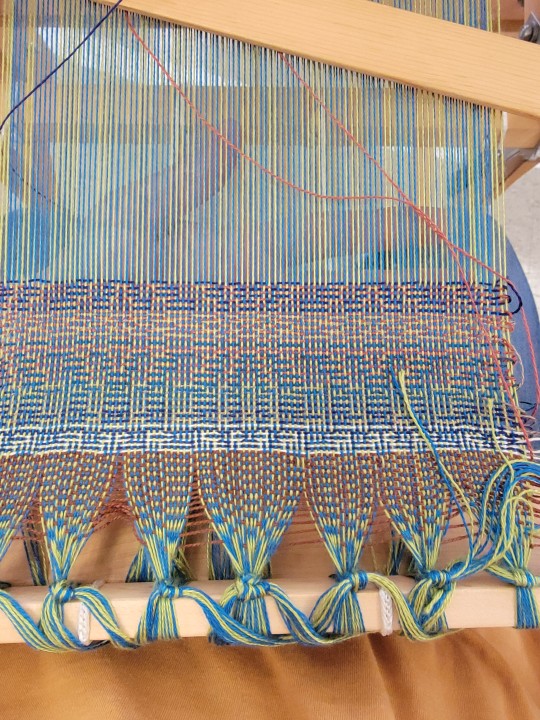
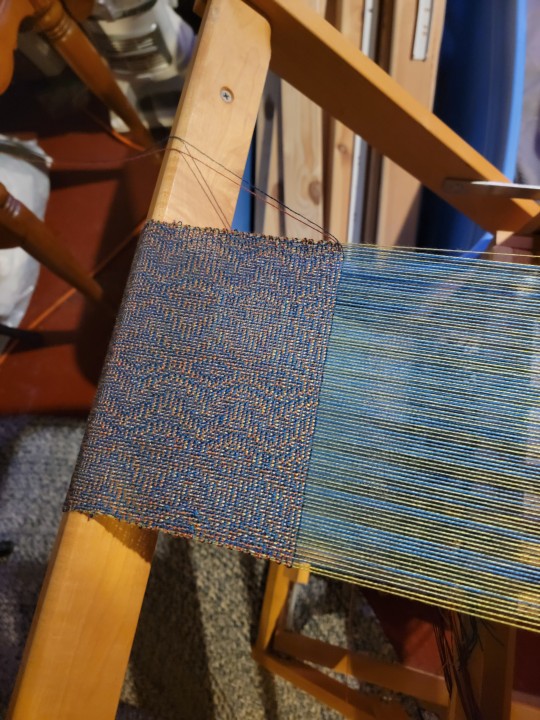

Now I have this 76in scarf made of a fiber that won't keep me warm. I'll absolutely never wear something like this. I'm thinking about cutting it and sewing it into drawstring bags. Maybe add some beaded fringe? Idk, I'll take other people's ideas.
581 notes
·
View notes
Text




This was an 8.5 yard warp for 8 tea towels. I ended up getting 9 and a half towels out of it, with a woven length of 7.3 yards. Ten years into this and I still can't make the math work right. 😅
The pattern is a 2/2 twill plaid I designed myself. Yarn is 8/2 unmercerized cotton in white, light green, and dark green. The hem is 1 inch, rolled and secured with a vine stitch.
55 notes
·
View notes
Text

haven’t posted on tumblr in like 6 yrs how do i do this again?
handwoven cotton, dec. 2024
#weaving#textiles#textile art#handweaving#please follow me i’m interesting#i want to get back into using social media & i need friends so badly#in lieu of an introduction here’s one section of the most recent warp i pulled off my loom#my work
406 notes
·
View notes
Text
My littlest weaving assistant.
Not pictured: her nipping at my toes when I try to treadle, like the worlds pointiest game of whack a mole lolllll


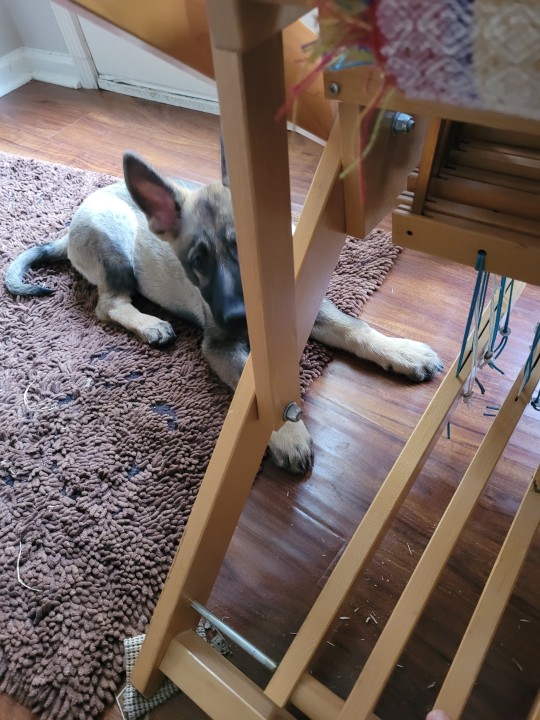
#shes trying so hard to be helpful but all she knows is bite things and Crime#bless her stupid lil heart#fibercraft#weaving#handcraft#puppy#handweaving#handwoven#loom weaving
4K notes
·
View notes
Text
Yesterday I got the big wool blankets warped up on the loom at the studio. It looks like Lisa Frank barf and I love it. It took almost the whole weekend to warp and I only got about 20 minutes of actual weaving in before I had to leave. I wanna go back!!


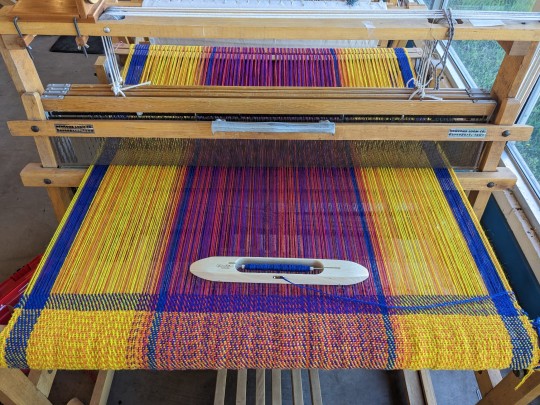
444 notes
·
View notes